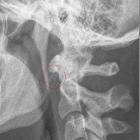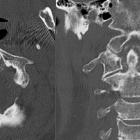akzessorische Ossikel des kraniozervikalen Übergangs




akzessorische Ossikel des kraniozervikalen Übergangs
Anomalien des kraniozervikalen Übergangs Radiopaedia • CC-by-nc-sa 3.0 • de
Craniovertebral junction (CVJ) anomalies can be congenital, developmental or due to malformation secondary to any acquired disease process. These anomalies can lead to cranial nerve compression, vertebral artery compression and obstructive hydrocephalus.
Pathology
The craniovertebral junction is formed by the occipital condyles, atlas (C1), axis (C2) vertebrae and their articulations. Any process which can give rise to malformation of these structures, may result in CVJ anomaly. It can be due to congenital, developmental or acquired cause.
On this basis of etiology, CVJ malformations can be classified as:
Congenital anomalies and malformations
Malformations of the occipital sclerotome
- remnants of proatlas
- platybasia
- occipital condylar hypoplasia
- condylar dysplasia (condylus tertius, paracondylar process, and basilar process)
- segmentation anomaly of the clivus
- atlas assimilation
Malformations of atlas vertebra
- atlas assimilation
- bifid arches
- aplasia and hypoplasia of the atlas
Malformation of axis and odontoid process
- atlantoaxial fusion
- persistent ossiculum terminale
- os odontoideum
- odontoid dysplasia
Developmental and acquired malformations
Malformations at foramen magnum
- basilar invagination
-
paramesial invagination
Atlantoaxial instability
-
infections
trauma
-
inborn errors of metabolism
-
neoplastic
osteofibroma
-
other
Conradi syndrome

 Assoziationen und Differentialdiagnosen zu akzessorische Ossikel des kraniozervikalen Übergangs:
Assoziationen und Differentialdiagnosen zu akzessorische Ossikel des kraniozervikalen Übergangs:



